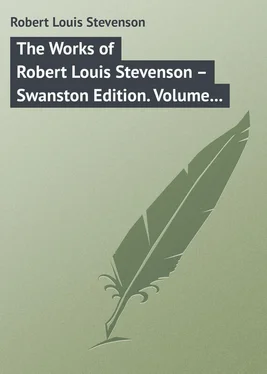Robert Stevenson - The Works of Robert Louis Stevenson – Swanston Edition. Volume 17
Здесь есть возможность читать онлайн «Robert Stevenson - The Works of Robert Louis Stevenson – Swanston Edition. Volume 17» — ознакомительный отрывок электронной книги совершенно бесплатно, а после прочтения отрывка купить полную версию. В некоторых случаях можно слушать аудио, скачать через торрент в формате fb2 и присутствует краткое содержание. ISBN: , Жанр: foreign_prose, на английском языке. Описание произведения, (предисловие) а так же отзывы посетителей доступны на портале библиотеки ЛибКат.
- Название:The Works of Robert Louis Stevenson – Swanston Edition. Volume 17
- Автор:
- Жанр:
- Год:неизвестен
- ISBN:http://www.gutenberg.org/ebooks/31012
- Рейтинг книги:4 / 5. Голосов: 1
-
Избранное:Добавить в избранное
- Отзывы:
-
Ваша оценка:
- 80
- 1
- 2
- 3
- 4
- 5
The Works of Robert Louis Stevenson – Swanston Edition. Volume 17: краткое содержание, описание и аннотация
Предлагаем к чтению аннотацию, описание, краткое содержание или предисловие (зависит от того, что написал сам автор книги «The Works of Robert Louis Stevenson – Swanston Edition. Volume 17»). Если вы не нашли необходимую информацию о книге — напишите в комментариях, мы постараемся отыскать её.
The Works of Robert Louis Stevenson – Swanston Edition. Volume 17 — читать онлайн ознакомительный отрывок
Ниже представлен текст книги, разбитый по страницам. Система сохранения места последней прочитанной страницы, позволяет с удобством читать онлайн бесплатно книгу «The Works of Robert Louis Stevenson – Swanston Edition. Volume 17», без необходимости каждый раз заново искать на чём Вы остановились. Поставьте закладку, и сможете в любой момент перейти на страницу, на которой закончили чтение.
Интервал:
Закладка:
The native opposition, I say, was in a sense continuous. And it kept continuously growing. The sphere of Brandeis was limited to Mulinuu and the north central quarters of Upolu – practically what is shown upon the map opposite. There the taxes were expanded; in the out-districts, men paid their money and saw no return. Here the eye and hand of the dictator were ready to correct the scales of justice; in the out-districts, all things lay at the mercy of the native magistrates, and their oppressions increased with the course of time and the experience of impunity. In the spring of the year, a very intelligent observer had occasion to visit many places in the island of Savaii. “Our lives are not worth living,” was the burthen of the popular complaint. “We are groaning under the oppression of these men. We would rather die than continue to endure it.” On his return to Apia, he made haste to communicate his impressions to Brandeis. Brandeis replied in an epigram: “Where there has been anarchy in a country, there must be oppression for a time.” But unfortunately the terms of the epigram may be reversed; and personal supervision would have been more in season than wit. The same observer who conveyed to him this warning thinks that, if Brandeis had himself visited the districts and inquired into complaints, the blow might yet have been averted and the government saved. At last, upon a certain unconstitutional act of Tamasese, the discontent took life and fire. The act was of his own conception; the dull dog was ambitious. Brandeis declares he would not be dissuaded; perhaps his adviser did not seriously try, perhaps did not dream that in that welter of contradictions, the Samoan constitution, any one point would be considered sacred. I have told how Tamasese assumed the title of Tuiatua. In August 1888 a year after his installation, he took a more formidable step and assumed that of Malietoa. This name, as I have said, is of peculiar honour; it had been given to, it had never been taken from, the exiled Laupepa; those in whose grant it lay, stood punctilious upon their rights; and Tamasese, as the representative of their natural opponents, the Tupua line, was the last who should have had it. And there was yet more, though I almost despair to make it thinkable by Europeans. Certain old mats are handed down, and set huge store by; they may be compared to coats of arms or heirlooms among ourselves; and to the horror of more than one-half of Samoa, Tamasese, the head of the Tupua, began collecting Malietoa mats. It was felt that the cup was full, and men began to prepare secretly for rebellion. The history of the month of August is unknown to whites; it passed altogether in the covert of the woods or in the stealthy councils of Samoans. One ominous sign was to be noted; arms and ammunition began to be purchased or inquired about; and the more wary traders ordered fresh consignments of material of war. But the rest was silence; the government slept in security; and Brandeis was summoned at last from a public dinner, to find rebellion organised, the woods behind Apia full of insurgents, and a plan prepared, and in the very article of execution, to surprise and seize Mulinuu. The timely discovery averted all; and the leaders hastily withdrew towards the south side of the island, leaving in the bush a rear-guard under a young man of the name of Saifaleupolu. According to some accounts, it scarce numbered forty; the leader was no great chief, but a handsome, industrious lad who seems to have been much beloved. And upon this obstacle Brandeis fell. It is the man’s fault to be too impatient of results; his public intention to free Samoa of all debt within the year, depicts him; and instead of continuing to temporise and let his enemies weary and disperse, he judged it politic to strike a blow. He struck it, with what seemed to be success, and the sound of it roused Samoa to rebellion.
About two in the morning of August 31st, Apia was wakened by men marching. Day came, and Brandeis and his war-party were already long disappeared in the woods. All morning belated Tamaseseites were still to be seen running with their guns. All morning shots were listened for in vain; but over the top of the forest, far up the mountain, smoke was for some time observed to hang. About ten a dead man was carried in, lashed under a pole like a dead pig, his rosary (for he was a Catholic) hanging nearly to the ground. Next came a young fellow wounded, sitting in a rope swung from a pole; two fellows bearing him, two running behind for a relief. At last about eleven, three or four heavy volleys and a great shouting were heard from the bush town Tanungamanono; the affair was over, the victorious force, on the march back, was there celebrating its victory by the way. Presently after, it marched through Apia, five or six hundred strong, in tolerable order and strutting with the ludicrous assumption of the triumphant islander. Women who had been buying bread ran and gave them loaves. At the tail end came Brandeis himself, smoking a cigar, deadly pale, and with perhaps an increase of his usual nervous manner. One spoke to him by the way. He expressed his sorrow the action had been forced on him. “Poor people, it’s all the worse for them!” he said. “It’ll have to be done another way now.” And it was supposed by his hearer that he referred to intervention from the German war-ships. He meant, he said, to put a stop to head-hunting; his men had taken two that day, he added, but he had not suffered them to bring them in, and they had been left in Tanungamanono. Thither my informant rode, was attracted by the sound of wailing, and saw in a house the two heads washed and combed, and the sister of one of the dead lamenting in the island fashion and kissing the cold face. Soon after, a small grave was dug, the heads were buried in a beef box, and the pastor read the service. The body of Saifaleupolu himself was recovered unmutilated, brought down from the forest, and buried behind Apia.
The same afternoon, the men of Vaimaunga were ordered to report in Mulinuu, where Tamasese’s flag was half-masted for the death of a chief in the skirmish. Vaimaunga is that district of Taumasanga which includes the bay and the foothills behind Apia; and both province and district are strong Malietoa. Not one man, it is said, obeyed the summons. Night came, and the town lay in unusual silence; no one abroad; the blinds down around the native houses, the men within sleeping on their arms; the old women keeping watch in pairs. And in the course of the two following days all Vaimaunga was gone into the bush, the very gaoler setting free his prisoners and joining them in their escape. Hear the words of the chiefs in the 23rd article of their complaint: “Some of the chiefs fled to the bush from fear of being reported, fear of German men-of-war, constantly being accused, etc., and Brandeis commanded that they were to be shot on sight. This act was carried out by Brandeis on the 31st day of August, 1888. After this we evaded these laws; we could not stand them; our patience was worn out with the constant wickedness of Tamasese and Brandeis. We were tired out and could stand no longer the acts of these two men.”
So through an ill-timed skirmish, two severed heads, and a dead body, the rule of Brandeis came to a sudden end. We shall see him a while longer fighting for existence in a losing battle; but his government – take it for all in all, the most promising that has ever been in these unlucky islands – was from that hour a piece of history.
CHAPTER V
THE BATTLE OF MATAUTU
The revolution had all the character of a popular movement. Many of the high chiefs were detained in Mulinuu; the commons trooped to the bush under inferior leaders. A camp was chosen near Faleula, threatening Mulinuu, well placed for the arrival of recruits and close to a German plantation from which the force could be subsisted. Manono came, all Tuamasanga, much of Savaii, and part of Aana, Tamasese’s own government and titular seat. Both sides were arming. It was a brave day for the trader, though not so brave as some that followed, when a single cartridge is said to have been sold for twelve cents currency – between nine and ten cents gold. Yet even among the traders a strong party feeling reigned, and it was the common practice to ask a purchaser upon which side he meant to fight.
Читать дальшеИнтервал:
Закладка:
Похожие книги на «The Works of Robert Louis Stevenson – Swanston Edition. Volume 17»
Представляем Вашему вниманию похожие книги на «The Works of Robert Louis Stevenson – Swanston Edition. Volume 17» списком для выбора. Мы отобрали схожую по названию и смыслу литературу в надежде предоставить читателям больше вариантов отыскать новые, интересные, ещё непрочитанные произведения.
Обсуждение, отзывы о книге «The Works of Robert Louis Stevenson – Swanston Edition. Volume 17» и просто собственные мнения читателей. Оставьте ваши комментарии, напишите, что Вы думаете о произведении, его смысле или главных героях. Укажите что конкретно понравилось, а что нет, и почему Вы так считаете.










